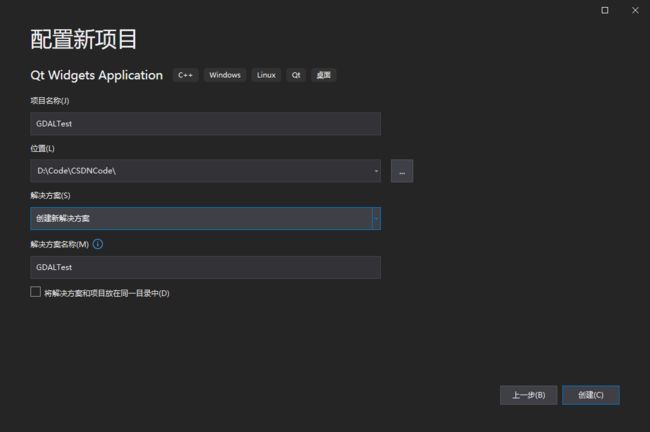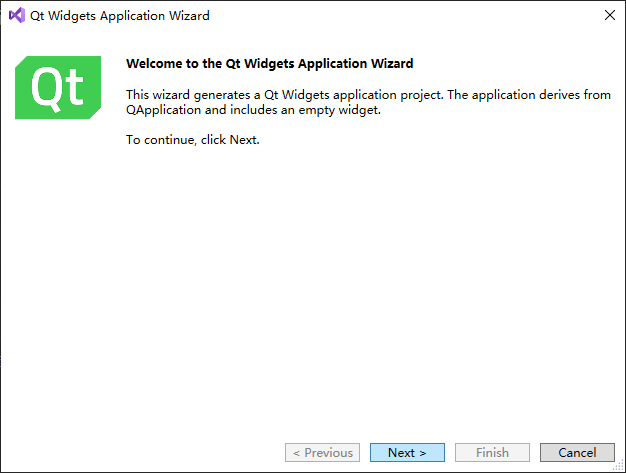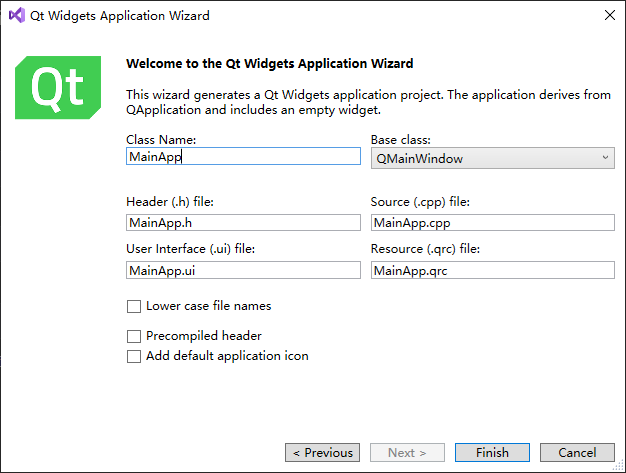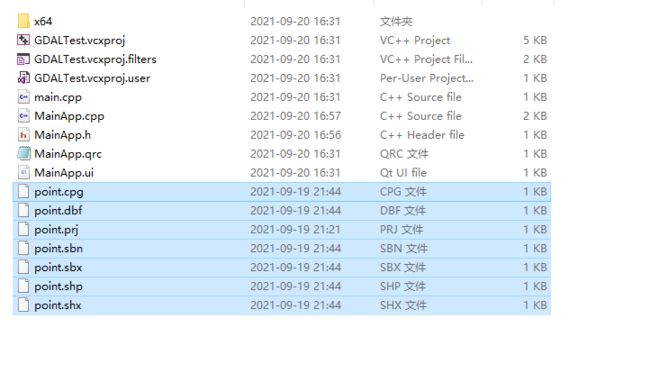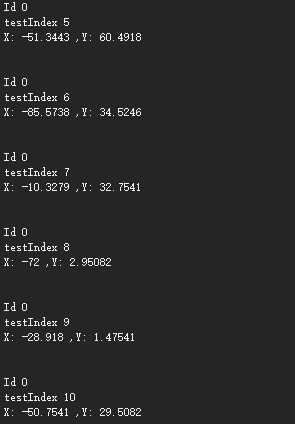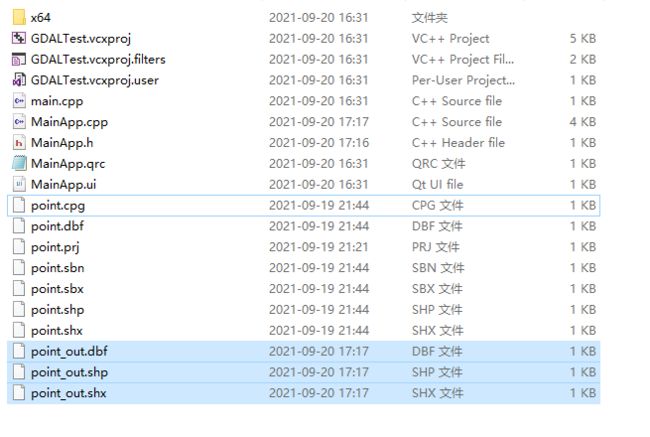Visual Studio2019 在Qt环境下使用GDAL读写点Shapefile文件
本教程是为QGIS的插件开发打基础噢!
要求:
环境要求:Visual Studio 2019+>Qt5.9
GDAL:>2.3
关于如何在Visual Studio2019中使用Qt开发,以及如何在Visual Studio中配置GDAL,大家有不知道的可以移步至我的下面两篇博客,有详细的介绍噢!
1、 Visual Studio 2019使用Qt开发
2、 Visual Studio2019配置GDAL
1、Vs中新建Qt项目
(1)在Visual Studio中创建新项目面板,选择Qt Widgets Application,点击下一步;
(2)在配置新项目面板,选择存放路径以及项目名称后点击创建;
(3)在Qt Widgets项目创建向导面板,点击next
(4)选择Debug版本,点击next;
(5)填写自己想要的类名,Base Class选择QMainWindow,点击finish,完成项目的创建
(6)点击运行,如果弹出下面的窗口,说明项目创建成功啦!
2、使用ArcMap创建GDAL读取需要的点图层文件
(1)ArcMap新建点图层的操作就不多说了,大家不会的自行查阅,也可以在文末的云盘分享里面免费获取噢!新建好图层后,我们加上测试属性testIndex(需要开启编辑噢!),如下图所示;
(2)将point图层文件复制到我们刚刚创建的项目文件下,如下图所示,一共有七个文件!
3、使用GDAL读写shpfile文件
(1)GDAL读point.shp文件
1)在MainApp.h中新增以下函数;
bool gdalReadShp(const char* path);2)在MainApp.cpp中完成函数定义;
//头文件在最上面定义
#include "ogrsf_frmts.h"
#include
#include
#include
#include
#include
//......
bool MainApp::gdalReadShp(const char* path) {
//注册数据驱动
GDALAllRegister();
//打开数据文件
GDALDataset* poDS;
poDS = (GDALDataset*)GDALOpenEx(path, GDAL_OF_VECTOR, NULL, NULL, NULL);
if (poDS == NULL)
{
qDebug() << "read failed" << endl;
return false;
}
else {
qDebug() << "read success" << endl;
//获取图层数量
qDebug() << "LayerCount:" << poDS->GetLayerCount();
OGRLayer* poLayer;
poLayer = poDS->GetLayerByName("point");
for (auto& poFeature : poLayer)
{
for (auto&& oField : *poFeature)
{
switch (oField.GetType())
{
case OFTInteger:
qDebug() << oField.GetName() << (oField.GetInteger());
break;
case OFTInteger64:
qDebug() << oField.GetName()<<(oField.GetInteger64());
break;
case OFTReal:
qDebug() << oField.GetName()<<(oField.GetDouble());
break;
case OFTString:
qDebug() << oField.GetName()<<(oField.GetString());
break;
default:
qDebug() << oField.GetName()<<(oField.GetAsString());
break;
}
}
OGRGeometry* poGeometry;
poGeometry = poFeature->GetGeometryRef();
if (poGeometry != NULL
&& wkbFlatten(poGeometry->getGeometryType()) == wkbPoint)
{
#if GDAL_VERSION_NUM >= GDAL_COMPUTE_VERSION(2,3,0)
OGRPoint* poPoint = poGeometry->toPoint();
#else
OGRPoint* poPoint = (OGRPoint*)poGeometry;
#endif
qDebug() << "X:" << poPoint->getX() << ",Y:" << poPoint->getY();
}
else
{
qDebug() << "no point geometry";
}
qDebug() << endl;
}
//关闭数据链接
GDALClose(poDS);
return true;
}
} 3)在构造函数中调用该读取函数;
gdalReadShp("point.shp");4)在右下角输出框中就可以看点图层的属性和地理位置啦!
(2)GDAL写point.shp文件
1)在MainApp.h中新增以下函数;
bool gdalWriteShp();2)在MainApp.cpp中完成函数定义,创建包含三个点的shapefile文件,并且我们添加了
一个属性Name;
bool MainApp::gdalWriteShp() {
//先注册所有驱动程序
GDALAllRegister();
//获取shapeFile驱动程序
const char* pszDriverName = "ESRI Shapefile";
GDALDriver* poDriver;
poDriver = GetGDALDriverManager()->GetDriverByName(pszDriverName);
if (poDriver == NULL)
{
qDebug() << "driver not available." << endl;
return false;
}
//通过shapeFile数据驱动创建点shp文件
GDALDataset* poDS;
poDS = poDriver->Create("point_out.shp", 0, 0, 0, GDT_Unknown, NULL);
if (poDS == NULL)
{
qDebug() << "Creation of output file failed." << endl;
return false;
}
OGRLayer* poLayer;
poLayer = poDS->CreateLayer("point_out", NULL, wkbPoint, NULL);
if (poLayer == NULL)
{
qDebug() << "Layer creation failed." << endl;
return false;
}
//为点数据创建属性字段
OGRFieldDefn oField("Name", OFTString);
//设置属性字段精度
oField.SetWidth(32);
if (poLayer->CreateField(&oField) != OGRERR_NONE)
{
qDebug() << "Creating Name field failed." << endl;
return false;
}
//新建要素
double x = 20, y = 20;
double xArr[3] = { 20.1,20.2,20.3 };
double yArr[3] = { 20.1,20.2,20.3 };
char* szName[3] = { "Name1","Name2","Name3" };
for (int i = 0; i < 3; i++) {
OGRFeature* poFeature;
poFeature = OGRFeature::CreateFeature(poLayer->GetLayerDefn());
poFeature->SetField("Name", szName[i]);
OGRPoint pt;
pt.setX(xArr[i]);
pt.setY(yArr[i]);
poFeature->SetGeometry(&pt);
if (poLayer->CreateFeature(poFeature) != OGRERR_NONE)
{
qDebug() << "Failed to create feature in shapefile." << endl;
return false;
}
OGRFeature::DestroyFeature(poFeature);
}
GDALClose(poDS);
return true;
}3)在构造函数中运行函数
bool temp = gdalWriteShp();4)运行项目,就可以在项目文件夹中看到创建的shapefile啦!
5)在ArcMap中打开创建的点图层,可以看到Name属性也已经添加上去了!
4、文件分享
链接:point图层
提取码:ccyy

